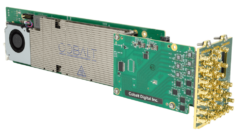Trends In Sports AV Design
In their quest to excite, entertain, sell, and market, sporting venues of all shapes and sizes are deploying cutting-edge AV systems at a clip that’s keeping everyone from architects to construction companies to AV systems consultants and integrators busy.
The aroma of hot dogs and freshly mown grass, sipping a cold beverage under the afternoon sun, singing “Take Me Out to the Ball Game” during the 7th inning stretch to the lazy strains of an organ — an idyllic day at the old ballpark. The ballpark of yesterday, that is. If not already shattered, many traditional sensory experiences associated with live sporting events have at least been upstaged in recent years by an onslaught of venue-based AV wizardry.
Thanks largely to the pro AV industry and its magic, no matter what the featured athletic contest may be, it has to compete mightily for undivided fan attention these days. Thunderous music emanating from massive loudspeaker systems; towering scoreboards that pulsate with live video, replays, static images, and advertising; digital signage at every turn; even touchscreen Internet kiosks — they’re all giving fans something else to see, hear, and do.
In their quest to excite, entertain, sell, and market, sporting venues of all shapes and sizes are deploying cutting-edge AV systems at a clip that’s keeping everyone from architects to construction companies to AV systems consultants and integrators busy. Facility renovations are routinely seen as an opportunity to extensively upgrade AV system capabilities. Newly constructed facilities are providing a blank slate for pulling out all the stops in building out a state-of-the-art AV showcase. Here are three trends driving the growing application of AV technology in sports venues.
1. A video spectacle
Perhaps the most visible AV trend in the sports venue market is the growing interest in enhancing video capabilities throughout the facility. From adding more and larger LED surfaces to the scoreboard to installing plasma displays that carry digital signage to outfitting skyboxes with HDTV-ready television, clients are looking for more ways to get fans watching more than just the game.
A designer of AV systems for numerous sports projects, Dallas-based Acoustic Dimensions has seen steady growth in the amount of money sports clients are willing to spend on high-quality video.
“Display manufacturers are going great guns with having their products added in renovations for facilities that are just a couple of years old,” says Stuart Reynolds, a senior consultant with the firm. “A trend that started in pro basketball — 360-degree LED signage on the arena’s balcony fascia — is now showing up in baseball and football stadiums as a way to put on more of a show with marketing and advertising.”
Dodger Stadium in Los Angeles recently became the latest Major League ballpark to sport a fascia-based LED display. As part of a broader AV renovation that Acoustic Dimensions coordinated, Brookings, SD-based Daktronics, a scoreboard technology specialist, installed the LED display on a 1,100-foot run of the fascia.
2. Concert-quality sound
Sound is also getting its share of attention in stadium and arena AV makeovers. The days of viewing the sound system as merely a vehicle for public address are fading as facility owners strive to make music and sound effects a part of the game-day experience.
“The audio quality that fans expect has risen dramatically, so stadium sound is getting more sophisticated,” says George Douglas, senior vice president at SPL Integrated Solutions, a Columbia, MD-based AV systems integrator with extensive sports venue experience. “Sound systems have come a long way from the old speaker-on-a-stick approach. Now, large distributed sound systems that include upwards of 600 speakers are commonplace.”
All Pro Sound, a Pensacola, FL-based systems integrator, has designed and installed numerous sound system upgrades as part of college sports facility renovation jobs. Bobby Taylor, company director, says concert-style, line array sound systems are in demand because there’s zero tolerance for dead spots in coverage anymore.
“These systems require creativity to make them work in a high SPL environment, but sound quality is increasingly important from both a stadium advertising message and a crowd excitement perspective,” Taylor says. “Plus, they have to accommodate future seating expansion.”
3. Planning for the future
As the demand grows for originating and distributing high-quality audio and video, stadiums and arenas are focusing on building out the necessary infrastructure. Installation of fiber-optic cable that can carry high-definition television signals and digital audio and video is an essential element of most projects. That trend is evidence to the theory that sports venues are increasingly taking on the character of broadcast production facilities.
“They use a lot of the same technology as the broadcast market, but it’s just applied differently,” says Jeff Volk, who heads the sports entertainment group of Alpha Video, a systems integration firm located in Edina, MN. “We’re seeing a lot of interest in moving from legacy analog capabilities to digital, and also to high-definition.”
Gary McAuliffe, a senior consultant with Pelton Marsh Kinsella, a Dallas-based AV systems designer, says sports venue clients are working to position themselves for the future. “To future-proof their facilities from the eventual end of analog broadcasts, they’re moving rapidly toward digital distribution and capabilities that will allow them to handle virtually any kind of signal,” he says.
Though few stadiums are now equipped to originate or route high-definition signals, many are outfitting areas such as skyboxes with HD-capable displays in anticipation of an eventual infrastructure enhancement, says Acoustic Dimensions’ Reynolds.
While most of the AV technology going into sporting venues serves to enhance game-day functions, some of it is being geared to boost opportunities for fuller facility utilization. Meeting rooms, lounges, and even skybox facilities are being outfitted with displays, projection systems, and DSP-based sound systems that can serve as a draw for everything from business functions to wedding receptions.
“Room-based presentation systems are common on almost every stadium project now,” McAuliffe says. “Some are now able to use that technology to help rent out facilities for up to 80 days a year in some cases.”
Tom Zind is a freelance writer and researcher based in Prairie Village, KS. He has written for a variety of business-to-business publications and can be reached at[email protected].









